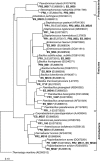Cultivation of anaerobic and facultatively anaerobic bacteria from spacecraft-associated clean rooms
- PMID: 19363082
- PMCID: PMC2687301
- DOI: 10.1128/AEM.02565-08
Cultivation of anaerobic and facultatively anaerobic bacteria from spacecraft-associated clean rooms
Abstract
In the course of this biodiversity study, the cultivable microbial community of European spacecraft-associated clean rooms and the Herschel Space Observatory located therein were analyzed during routine assembly operations. Here, we focused on microorganisms capable of growing without oxygen. Anaerobes play a significant role in planetary protection considerations since extraterrestrial environments like Mars probably do not provide enough oxygen for fully aerobic microbial growth. A broad assortment of anaerobic media was used in our cultivation strategies, which focused on microorganisms with special metabolic skills. The majority of the isolated strains grew on anaerobic, complex, nutrient-rich media. Autotrophic microorganisms or microbes capable of fixing nitrogen were also cultivated. A broad range of facultatively anaerobic bacteria was detected during this study and also, for the first time, some strictly anaerobic bacteria (Clostridium and Propionibacterium) were isolated from spacecraft-associated clean rooms. The multiassay cultivation approach was the basis for the detection of several bacteria that had not been cultivated from these special environments before and also led to the discovery of two novel microbial species of Pseudomonas and Paenibacillus.
Figures



References
-
- Anonymous. October 2002, posting date. COSPAR planetary protection policy. COSPAR/IAU Workshop on Planetary Protection, Committee on Space Research (COSPAR), International Council for Science, Paris, France. http://cosparhq.cnes.fr/Scistr/Pppolicy.htm.
-
- Aranki, A., and R. Freter. 1972. Use of anaerobic glove boxes for the cultivation of strictly anaerobic bacteria. Am. J. Clin. Nutr. 25:1329-1334. - PubMed
-
- Boston, P., M. V. Ivanov, and C. P. McKay. 1992. On the possibility of chemosynthetic ecosystems in subsurface habitats on Mars. Icarus 95:300-308. - PubMed
-
- Choi, J. H., W. T. Im, J. S. Yoo, S. M. Lee, D. S. Moon, H. J. Kim, S. K. Rhee, and D. H. Roh. 2008. Paenibacillus donghaensis sp. nov., a xylan-degrading and nitrogen-fixing bacterium isolated from East Sea sediment. J. Microbiol. Biotechnol. 18:189-193. - PubMed
Publication types
MeSH terms
Substances
Associated data
- Actions
- Actions
- Actions
- Actions
- Actions
- Actions
- Actions
- Actions
- Actions
- Actions
- Actions
- Actions
- Actions
- Actions
- Actions
- Actions
- Actions
- Actions
- Actions
- Actions
- Actions
- Actions
- Actions
- Actions
- Actions
- Actions
- Actions
- Actions
- Actions
- Actions
- Actions
- Actions
- Actions
- Actions
- Actions
- Actions
- Actions
- Actions
- Actions
- Actions
- Actions
- Actions
- Actions
- Actions
- Actions
LinkOut - more resources
Full Text Sources
Other Literature Sources
Molecular Biology Databases
Miscellaneous

